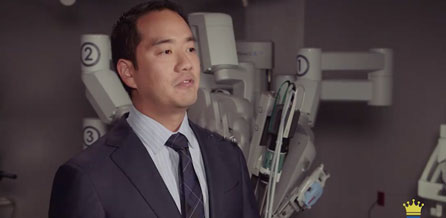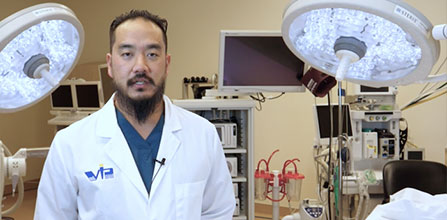Inguinal Hernia Surgery
Inguinal hernias refer to those hernias that occur in the groin area and are the same basic condition as any other abdominal hernia – a defect or hole through which either intestinal tissue or fat protrudes. Inguinal hernias are the most common hernia and represent upwards of 800,000 of the 1 million hernias repaired each year in the United States. Because of differences in anatomy, inguinal hernias disproportionately affect men. In fact, about 90% of all inguinal hernias occur in male patients and a man has about a 25% chance of developing one in his lifetime. By contrast only 1 in 50 females will develop an inguinal hernia in their lifetimes.
Each of us has an inguinal canal on either side of the abdomen. This canal allows the gonad (either testis or ovary) to pass through the abdomen. In men, the canal opening is more pronounced than in females. As such, it represents an inherent weak spot. Typically, the internal ring of the inguinal canal is small and does not allow intestinal tissue to enter. However, for a variety of reasons, the ring may expand, and a hernia may result.
Causes of an Inguinal Hernia
Most inguinal hernias are caused by strain on the abdomen – whether it is weightlifting, high-level sports, or simply lifting objects around the house. However, performing these activities does not necessarily lead to a hernia. Many weightlifters, despite lifting excessive weights over their entire careers, may never develop a hernia. Others, who are careful about what they lift, may get a hernia. Other causes and risk factors of developing an inguinal hernia include:
- Obesity
- COPD or other diseases that cause chronic cough
- Smoking
- Diabetes
- And more
There are also reasons, beyond strain and excess abdominal pressure, that can cause a hernia. There is certainly a genetic component to the development of a hernia. We know that children of those who have inguinal hernias are more likely to get one themselves.
Direct Versus Indirect Inguinal Hernias
Direct and indirect inguinal hernias reference the path that intestinal tissue takes rather than describing the hernia itself. An indirect hernia means that the intestinal tissue follows the entire inguinal canal – from the internal ring, through the inguinal canal, through the external ring and into the scrotum. Direct inguinal hernias take an abbreviated route through weakness in the abdominal wall directly into the scrotum. Both typically have the same signs and symptoms and are repaired in similar fashion.
Signs and Symptoms of an Inguinal Hernia
Inguinal hernias usually manifest in the form of a bulge in the lower abdomen or groin or even the scrotum. The bulge may, or may not, be accompanied by a feeling of heaviness, burning or pain.
Sometimes, inguinal hernias are mistaken for what is known as athletic pubalgia or a sports hernia. Athletic pubalgia does not represent an actual hernia, but rather a tear in the soft tissue of the groin – typically the oblique muscles or the adductors. Athletic pubalgia usually occurs in athletes, especially those playing sports that require twisting and fast turns.
While the risk is lower than a femoral hernia, inguinal hernias can also incarcerate and strangulate. Incarceration involves abdominal tissue (small intestine, large intestine or fat) that becomes stuck in the hernia defect and cannot be reduced (pushed back in). Strangulation occurs when blood flow is cut off and the trapped tissue begins to die.
Not all hernias are symptomatic, and many patients will go years, or their entire lives, without knowing ever had a hernia. We do not actively screen for asymptomatic hernias, but one may be found incidentally during an exam for another disease or condition.
When an Inguinal Hernia Becomes an Emergency
As mentioned above, when a hernia strangulates, this becomes a serious medical emergency. Patients only have a few hours to get appropriate care before tissue begins to die. The signs of a strangulated hernia include increasing, severe pain at the site of the hernia, a hernia bulge that does not reduce back into the abdomen when lying down and redness and swelling in the area. Patients should head directly to the emergency room if they experience these symptoms.
If left untreated, a strangulated hernia can be fatal. However, even if treatment is delayed, intestinal tissue can die, requiring additional surgery to remove the necrosed tissue. This invariably leads to a more difficult recovery and a much higher risk of complications.
Treatment for Inguinal Hernias
Typically, we recommend surgery for patients that are experiencing pain or bulging associated with their hernia. Younger patients are often ideal candidates for a hernia repair, while older patients, with a higher risk of surgery and a lower chance of strangulation may be advised to wait. While most patients will have the opportunity to choose between having surgery and watchful waiting, it is important to remember that hernias are a progressive condition – meaning that they will get worse. They will not improve on their own.
Regardless, treatment to correct an inguinal hernia requires surgery. While some practitioners may suggest the use of a hernia belt, this may be counterproductive and increase the risk of strangulation.
How Surgery Works
Hernia surgery is a relatively straightforward outpatient procedure performed at a hospital or an ambulatory surgery center.
Patients will be put under general anesthesia and the repair is most often performed in a minimally invasive manner with or without robotic assistance. Rarely, if the situation warrants, the procedure may be converted to open surgery. Inguinal hernias can also be present on both sides of the abdomen, known as a bilateral hernia. If this is the case, surgery will almost always be performed laparoscopically or robotically to access both sides of the abdomen during the same procedure.
Depending on the type of surgery being performed, three or four small incisions are made in the abdomen with the largest being in the navel or belly button to hide any scarring. During the procedure, Dr. Tsuda or Ryan will reduce the hernia by pulling any abdominal tissue out of the defect. A rolled piece of plastic (permanent) or absorbable mesh will be introduced through the incision in the belly button. The mesh is unrolled and placed carefully over the defect, ensuring that the hole is fully covered and allowing for some excess beyond the edges, for durability. One side of the mesh is coated with adhesive, which grips tightly to the abdominal tissue and eliminates the need for permanent or absorbable tacks to hold it in place.
Over the course of 6 to 8 weeks, the body develops scar tissue around this newly placed mesh. The scar tissue forms a very strong barrier over the defect.
The Advantages of the Minimally Invasive Approach
Today, the vast majority of elective hernia repairs are performed using the minimally invasive or robotic approach. This allows the surgeon to patch the defect from the inside of the abdomen meaning that any pressure placed on the abdomen after surgery supports the mesh in place. Further, the use of laparoscopic techniques means that only blunt dissection is used and the risk of irritation or damage to nerves is significantly reduced. Lastly, recovery is significantly shortened, and the risks of post-operative complications are reduced.
The Advantages of Using Hernia Mesh
If you’ve done your research on hernia surgery, you have heard some concern about hernia mesh as it relates to complications and most especially chronic pain after surgery. Today, hernia mesh is thinner, lighter and more technologically advanced, allowing for a significant reduction in potential complications.
Most importantly, mesh-based repairs have a significantly lower risk of recurrence – the hernia coming back – then repairs without mesh, which have a recurrence rate of 15% or more.
We also have a number of mesh materials to choose from. At its most basic, we have advanced plastic mesh that’s implanted permanently. Technological improvements have yielded absorbable mesh which, over the course of several weeks, dissolves into the body leaving only scar tissue. Even biological mesh, made from animal tissue, can be used to repair the defect.
This is where a hernia surgeon’s experience becomes of utmost importance. The sheer number, styles and types of mesh require an intimate knowledge of the patient’s particular situation. Understanding what the patient needs and matching them to an appropriate mesh is critical for a safe and effective outcome.
The Risks and Considerations of Inguinal Hernia Surgery
An inguinal hernia repair is major abdominal surgery and comes with inherent risks including infection, pain, blood loss, and a very small risk of death. Minimally invasive surgery and robotic assistance has significantly reduced the severity and likelihood of these potential complications.
Considerations Specific to an Inguinal Hernia Repair Include
- The risk of chronic pain after inguinal hernia surgery is widely disputed, with some studies showing an incidence of 10% while others show higher rates. New technology and refined techniques have allowed us to minimize the chance of chronic pain.
- Defect in mesh material can cause the migration or distortion of the mesh which, in turn, may cause the recurrence of the hernia. New hernia mesh technology has reduced this risk significantly. Mesh-based repairs have a recurrence risk of about 3%, while non-mesh-based repairs have recurrence rates of 15% or more.
- Nerve involvement and vascular injury can occur with any surgery and these risks are somewhat higher with the laparoscopic approach. This is where your surgeon’s experience becomes even more valuable. Dr. Tsuda and Dr. Ryan carefully identify important nerve bundles and blood vessels to minimize this risk.
- Patients who present to the emergency room with a strangulated hernia have a significantly higher risk of the above complications. If intestinal tissue necrosed as a result of a delay in care, intestinal surgery will be performed in addition to the hernia repair, which involves additional risks.
Final thoughts
Inguinal hernia repair, when performed in a non-emergency setting, is a safe and effective procedure in the hands of an experienced surgeon. Speaking to your surgeon about the benefits and risks as they relate to your particular situation is the next step.



